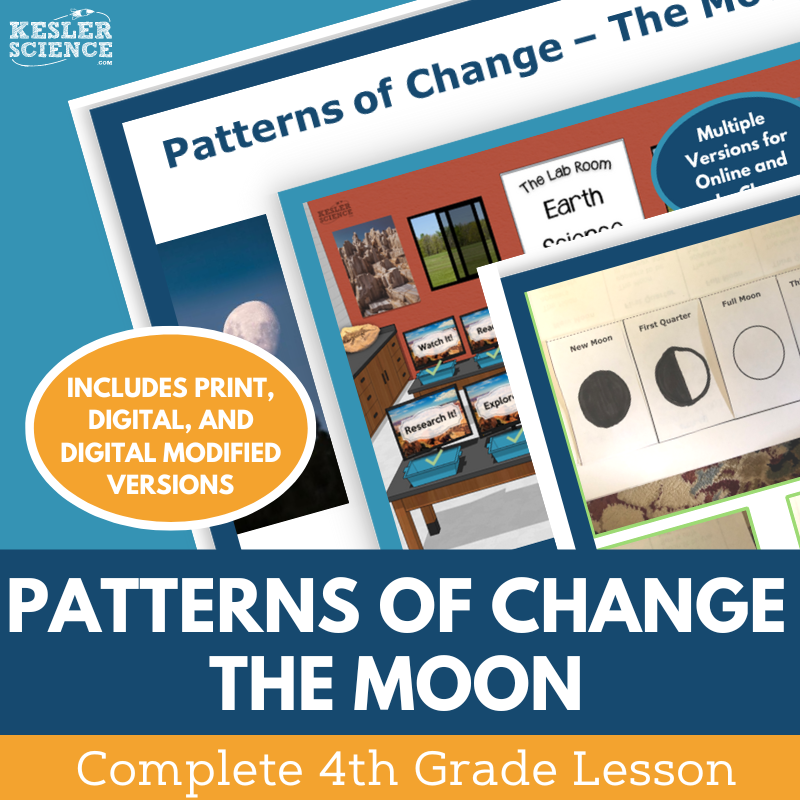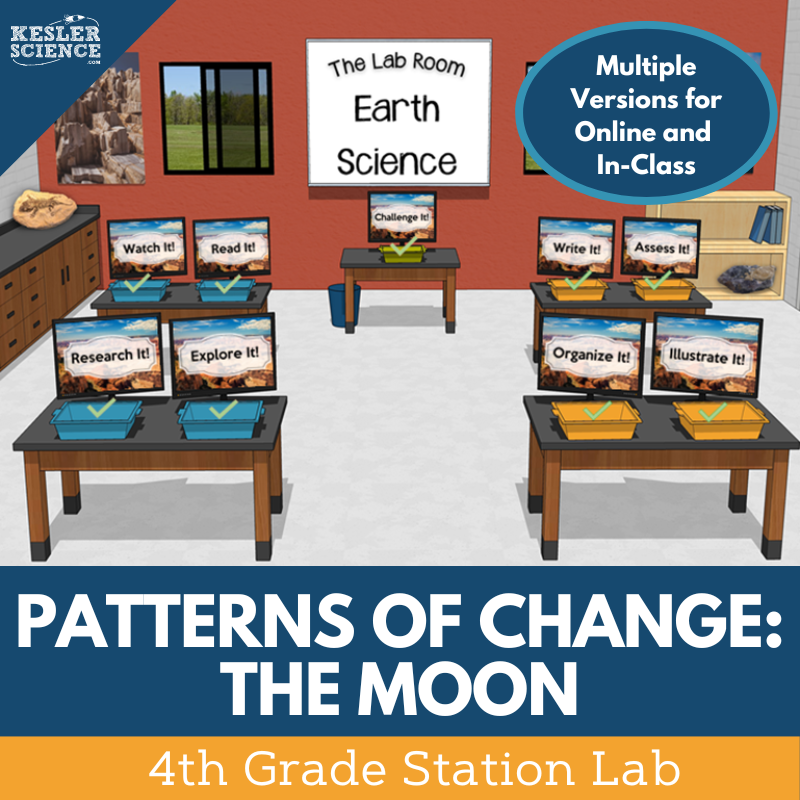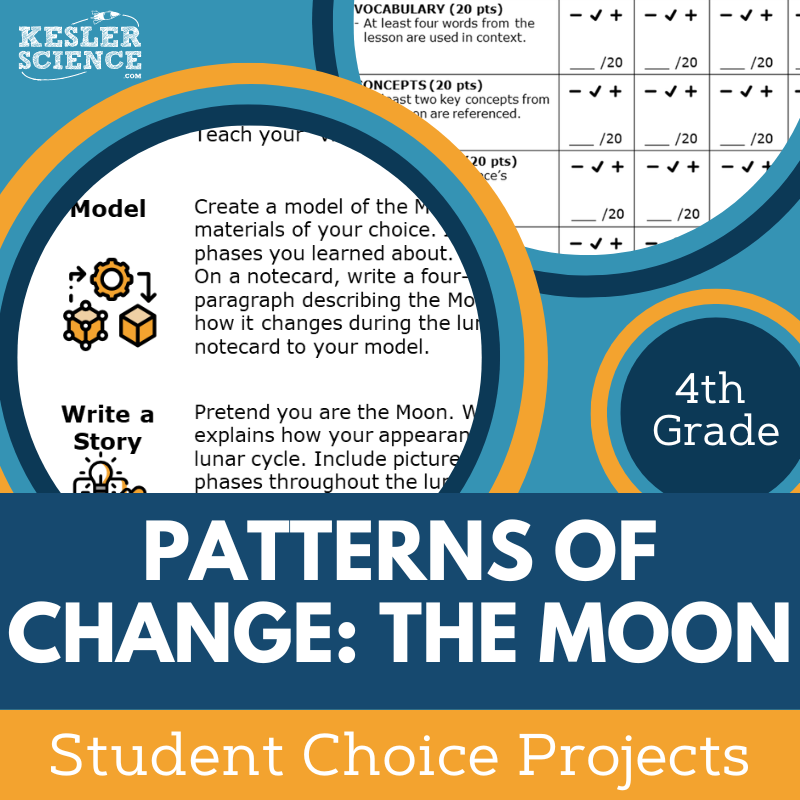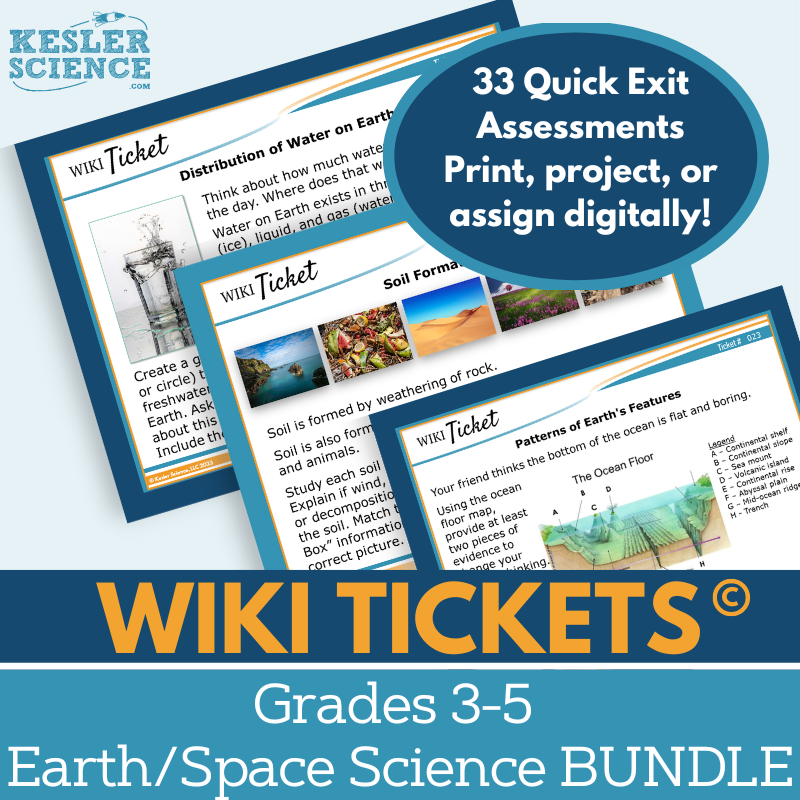Patterns of Change - the Moon Activities for 4th Grade Science
Kesler Science Patterns of Change – The Moon 4th Grade 5E Lesson engages students in discovering how the Moon’s appearance changes over time through a student-centered, hands-on approach. The resources below will give students a comprehensive understanding of moon phases. All of the following materials are also included in the Kesler Science Membership.
The Kesler Science Patterns of Change – The Moon 4th Grade Complete 5E Lesson provides everything needed for an engaging, multi-day exploration of how the Moon’s appearance changes over time. With minimal prep, students take charge of their learning through hands-on activities, differentiated resources, and multimodal instruction. Printable and digital formats offer flexibility, while editable PowerPoints and Spanish translations ensure accessibility for all learners.
Students discover lunar patterns through the well-researched 5E Model. In the Exploration phase, a nine-station, student-led lab allows learners to investigate through reading, research, videos, and hands-on experiments. Output stations encourage students to demonstrate understanding by organizing, writing, illustrating, and assessing key concepts, with an extra challenge station for enrichment.
Supporting materials include interactive notebooks, editable note-taking templates, and differentiated assessments. Whether used in-class or virtually, this lesson provides a dynamic, student-centered approach to understanding the Moon’s patterns of change.
The Kesler Science Patterns of Change – The Moon 4th Grade Complete 5E Lesson provides everything needed for an engaging, multi-day exploration of how the Moon’s appearance changes over time. With minimal prep, students take charge of their learning through hands-on activities, differentiated resources, and multimodal instruction. Printable and digital formats offer flexibility, while editable PowerPoints and Spanish translations ensure accessibility for all learners.
Students discover lunar patterns through the well-researched 5E Model. In the Exploration phase, a nine-station, student-led lab allows learners to investigate through reading, research, videos, and hands-on experiments. Output stations encourage students to demonstrate understanding by organizing, writing, illustrating, and assessing key concepts, with an extra challenge station for enrichment.
Supporting materials include interactive notebooks, editable note-taking templates, and differentiated assessments. Whether used in-class or virtually, this lesson provides a dynamic, student-centered approach to understanding the Moon’s patterns of change.
The Kesler Science Patterns of Change – The Moon Station Lab immerses 4th graders in hands-on exploration of lunar patterns, shadows, and seasonal changes. Students collect and analyze data to identify sequences and predict patterns, fostering deeper scientific understanding. The student-led structure ensures engagement while minimizing teacher prep time.
With eight differentiated stations and a challenge station for early finishers, students engage with new concepts through reading, videos, research, and hands-on activities. Output stations provide creative ways to demonstrate learning, including writing, illustrations, and manipulatives. The modular design allows for independent or small-group work.
This versatile lab requires minimal classroom materials and offers digital options for flexible learning environments. Whether in-person or virtual, students will explore and apply lunar science concepts in a meaningful, interactive way.
The Kesler Science Patterns of Change – The Moon Station Lab immerses 4th graders in hands-on exploration of lunar patterns, shadows, and seasonal changes. Students collect and analyze data to identify sequences and predict patterns, fostering deeper scientific understanding. The student-led structure ensures engagement while minimizing teacher prep time.
With eight differentiated stations and a challenge station for early finishers, students engage with new concepts through reading, videos, research, and hands-on activities. Output stations provide creative ways to demonstrate learning, including writing, illustrations, and manipulatives. The modular design allows for independent or small-group work.
This versatile lab requires minimal classroom materials and offers digital options for flexible learning environments. Whether in-person or virtual, students will explore and apply lunar science concepts in a meaningful, interactive way.
The Kesler Science Patterns of Change - The Moon Student Choice Projects give 4th graders the freedom to demonstrate their learning in a way that suits their strengths. With six structured project options and a “design your own” choice, students can engage with lunar patterns in a meaningful way. An editable rubric supports teacher, peer, or self-assessment.
Designed for flexibility, this resource includes a modified version with targeted support for students who need extra guidance, while advanced learners can combine multiple projects for deeper exploration. The multimodal approach ensures students can showcase their understanding through writing, visuals, or hands-on activities.
Using everyday classroom materials like paper, markers, and scissors, these projects encourage creativity and critical thinking. Many options can also be completed digitally, making them adaptable for any learning environment.
The Kesler Science Patterns of Change - The Moon Student Choice Projects give 4th graders the freedom to demonstrate their learning in a way that suits their strengths. With six structured project options and a “design your own” choice, students can engage with lunar patterns in a meaningful way. An editable rubric supports teacher, peer, or self-assessment.
Designed for flexibility, this resource includes a modified version with targeted support for students who need extra guidance, while advanced learners can combine multiple projects for deeper exploration. The multimodal approach ensures students can showcase their understanding through writing, visuals, or hands-on activities.
Using everyday classroom materials like paper, markers, and scissors, these projects encourage creativity and critical thinking. Many options can also be completed digitally, making them adaptable for any learning environment.
The Kesler Science Earth/Space WIKI Tickets provide fun, easy formative assessments for 3rd–5th grade science. This set includes 33 engaging exit tickets aligned to NGSS and TEKS, covering topics like the water cycle, Earth's rotation, weather patterns, and natural resources.
Each topic features five formats: a full-screen display for projection, three printable handout sizes, and an interactive digital version compatible with PowerPoint and Google Slides. A bonus table of contents file ensures easy standard alignment.
WIKI Tickets (“What I Know Is”) serve as exit tickets, bellringers, or quick checks for understanding, making them a flexible tool for both in-person and virtual learning environments.
The Kesler Science Earth/Space WIKI Tickets provide fun, easy formative assessments for 3rd–5th grade science. This set includes 33 engaging exit tickets aligned to NGSS and TEKS, covering topics like the water cycle, Earth's rotation, weather patterns, and natural resources.
Each topic features five formats: a full-screen display for projection, three printable handout sizes, and an interactive digital version compatible with PowerPoint and Google Slides. A bonus table of contents file ensures easy standard alignment.
WIKI Tickets (“What I Know Is”) serve as exit tickets, bellringers, or quick checks for understanding, making them a flexible tool for both in-person and virtual learning environments.
Year-Round Resources
These year-round activities will increase your students' understanding of many middle school science topics. All of these activities are also included in the Kesler Science Membership.
Visual Data & Graphing
You're not alone if your students struggle with understanding graphs, charts, and tables. It's a skill that takes an enormous amount of practice. This resource will help students build a strong foundation in analyzing data and creating their own data visualizations.
Bell Ringers and Warm-Ups
These middle school science bell ringers are an excellent way to engage your students as soon as they walk into your classroom. This comprehensive FULL YEAR resource includes everything you need to start off each science class with an interesting warm-up activity.
Review Board Games
Each game board has been carefully designed to keep students engaged. There are 10 different action spaces on each board and dozens of question cards. All of the actions are related to science concepts and keep the students motivated throughout the game.
Each game is ready to play. Simply print out the board and the cards and let the students enjoy reviewing nine different units.
Essential Questions
Below are the essential questions associated with the lessons and activities included in this unit. This topic is only one of more than 100 middle school science topics included in the Kesler Science Membership.
-
How does the appearance of the Moon change over time?
Kesler Science Membership
Imagine never having to search for another middle school science lesson again. The membership gives you access to ALL of the Kesler Science products in one place (Yes, including everything above).
Say goodbye to long hours of lesson prep.









